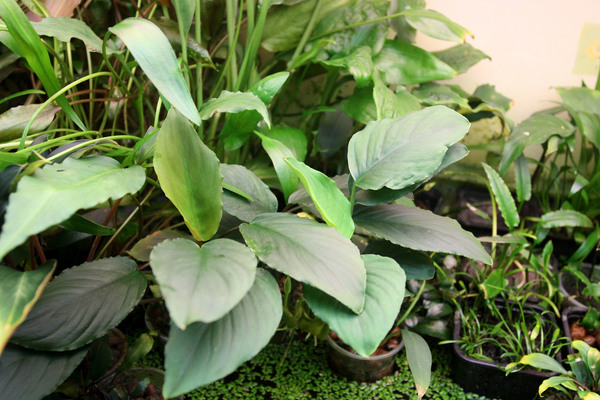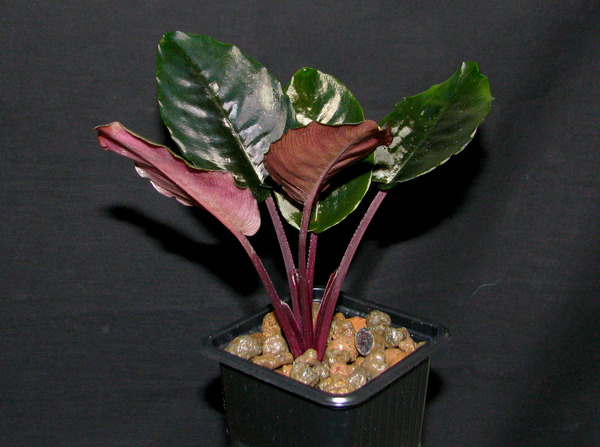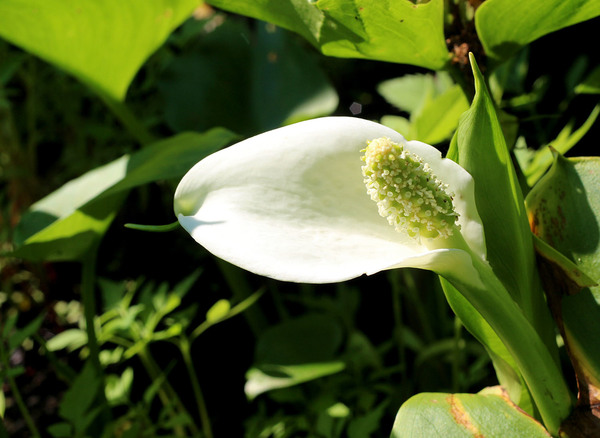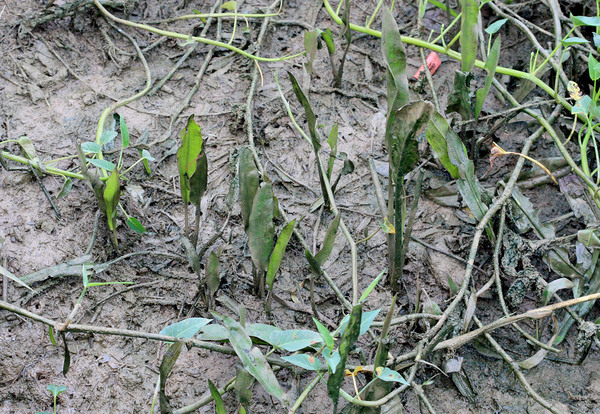Good News for Aquarists: Artificial Hybrids of Bucephalandra kishii
Dedicated to the 85th birth anniversary of Josef Bogner (1939–2020), who was always in contact with both scientists and hobbists
We have already reported [1] that generative propagation of Bucephalandra is an extremely effective approach to the mass reproduction and improvement of these plants. Now it is time to talk about selection.
According to “The Überlist of Araceae” [2], the species diversity of Bucephalandra is estimated at 50 species, the descriptions of 30 species have already been published [3,4]. With such a large number of natural species, the creation of new varieties with different colors and leaf shapes does not make much sense. It is a completely different case to create hybrids for specific purposes, for example, for keeping plants in a fish tank (underwater). Fishkeeping is a popular hobby among people in many countries around the world, and plants that can live under water for a long time are becoming extremely much in demand. This is especially true for plants of the Araceae family, since most of their natural species are not able to grow under water. In particular, this problem was previously successfully solved for Anubias. Only one of eight Anubias species (Anubias barteri) is able to live indefinitely long under water. Interspecific crossing of the latter with the other species made it possible to obtain a wide range of underwater Anubias with various decorative qualities [5].
Figure 1. The cultivated specimen of Bucephalandra kishii. Photo: S. Bodyagin.
Unlike Anubias, the situation with Bucephalandra is not so tragic - only a few are not able to live in an aquarium. However, one of the most beautiful Bucephalandra species, Bucephalandra kishii, tends to prefer living on land (Figure 1). A distinctive feature of this plant is the noticeably raised primary lateral veins, which, in combination with the dark color of the leaf, give it special decorative qualities. In this article, we will talk about our experience in creating artificial hybrids based on Bucephalandra kishii.
Подробнее: Good News for Aquarists: Artificial Hybrids of Bucephalandra kishii
Anubias by Seeds: from Start to Finish...
Originally published in German [1].
The advantages of generative plant propagation over vegetative are undeniable. These include many opportunities for creating new varieties and for «rejuvenating» old ones. Only the microclonal propagation can compete with seed propagation. However, microcloning requires special equipment and is difficult to perform at home, therefore is practically not possible for amateurs. In nature, propagation by seeds is common. Otherwise, most of the existing species would be doomed to extinction from various diseases. A similar situation concerns now aquarium plants, many of which found their way into amateur collections 30-40 years ago. The long-term vegetative propagation of these plants has caused various fungal and viral infections in their environment. The scale of diseases sometimes becomes catastrophic and leads to the complete loss of one or another species from the collections. This sad fate did not spare Anubias either.
Figure 1. The cultivated specimen of Anubias barteri var. glabra (commercial name is Anubias 'minima') in a greenhouse environment. Photo: D. Loginov.
Anubias selection has received a lot of attention in the literature. In particular, examples of the production of intra- and interspecific hybrids have been described [2,3]. These works report in detail about the advantages of generative reproduction of Anubias, as well as the decorative and other qualities of the resulting offspring. While the process of plant pollination, fruit ripening and seed germination are only of secondary importance. In this article, we tried to cover all the subtleties and secrets of seed propagation of Anubias. We hope that the following information will serve as a guide to action even for ordinary aquarists and aroiders.
A Rheophyte from Sumatra
Probably, each of you will find in your childhood memories how rich and amazing life was at that time. Every day brought many new discoveries. On the margin of an ordinary pond one could spend hours studying various dragonflies, snails, frogs and other living creatures. Or, lying on your back in the grass, you were peering into the shape of clouds running across the sky, performing a “heavenly” show that only you could understand. Unfortunately, as we get older, these things do not amuse us anymore, and sometimes we do not even notice them. But this nostalgia is deceptive. Man, by nature, always remains a researcher and, having learned some phenomena, starts searching for the new ones.
It is rare that an aquarist is content with only one type of fish or plant for several years. The irresistible craving for the unknown pushes him to obtain more and more new pets (Figure 1). However, at a certain point you realize that the range of living objects suitable for keeping in your fish tank is not so large. In addition, they are also systematically combined into groups (families, genera), the representatives of which have similar morphology and conditions of pet care. For example, plants of the Araceae family are represented in aquariums primarily by common Cryptocoryne and Anubias species. Moreover, you do not surprise anyone with Pistia or duckweed (In 2010, duckweeds were transferred from Lemnaceae into Araceae because the taxonomists had discovered an inflorescence of this single-leaf plants).
Figure 1. Home wet greenhouse with rare aroids from Southeast Asia.
In contrast to this, the appearance of some rheophytic aroids from the island of Kalimantan in aquariums looks revolutionary. In particular, Bucephalandra plants have rooted in the tanks of collectors in a short period and have been used even in aquascaping. It turned out that not only Kalimantan, but also the neighboring island of Sumatra is rich in surprises. Although, what new can this island offer except for the Sumatra barb (Puntius tetrazona) that has been one of the most popular fish among fish keepers for several decades?
An easy find: Cryptocoryne cordata var. siamensis
The exact coordinates of the Cryptocoryne habitats belong to exclusive information and are usually not openly published either in scientific articles nor in collectors' blogs. It is not worth criticizing them, this is their bread and butter, and sometimes just good intentions focusing on preserving plants in nature. Me and my colleagues went on a February trip to Southern Thailand without informational preparation, relying only on our luck. It turned out that luck in this country often favors travelers. Having traveled a long way (more than 200 km) south from Ranong city with a stop at the coral Surin Islands, we stopped at one of the roadside hotels in the Khao Lak resort. For the first time in the seven days of the journey, we took the decision to stay at the same hotel for more than one night in order to get some rest, and therefore the plans for the next day only included visiting several small streams flowing into the Andaman Sea. Those streams were at a distance of just 10-20 km from the hotel (Photo 1).
Photo 1. The small river Bang Niang near the Khao Lak Resort in Thailand is the habitat of Cryptocoryne cordata var. siamensis. Photo by Dmitry Loginov.
But even this was enough to record another productive day in the expedition report. After an unhurried breakfast, we first went to solve a more pressing problem - currency exchange. Unfortunately, due to the sanctions, the Russian traveler has to use only cash, which tends to run out unexpectedly. Having successfully filled our wallets with Thai baht, we reached the first stream only by noon. The stream flowed along the road leading to the Ton Chong Fa Waterfall, which belongs to the Khao Lak-Lam Ru National Park. We knew how high the prices for foreign tourists can be in such places, so we did not go to the source of the stream, but stopped the car on a road section with large tropical trees along the side of the road. Here, at least a little shadow fell on our vehicle, which gave us hope that it would not have time to turn into an oven in the hellish midday sun during the next hours.
Подробнее: An easy find: Cryptocoryne cordata var. siamensis
Nur's stepsisters
Oh those sisters! Even being relatives, they usually have a huge number of differences, and this applies not only to their appearance, but also to the internal content, or – should I say? - character. Let alone the sisters (Figure 1), whom Mother Nature separated in space for several hundred kilometers over several million years...
Figure 1. Map of the Malay Peninsula with locations of two varieties of Cryptocoryne nurii. The insert shows a photograph of Mohamed Nur.
The first of them languished in the shadow of a tropical forest in the waters of the Telepah River (Sungai Telepah), that flows from north to south northwest of the Malaysian administrative center of Kota Tinggi (Figure 2). The thirty-year-old collector Mohamed Nur (Mohamed Nur bin Mohamed Ghose) was not a newbie in his field: he had begun collecting tropical plants for the world's leading botanical gardens at the age of 15. Perhaps it was his rich experience that helped him not to miss such a miniature aquatic inhabitant, which 7 years later, in 1935, was named after him - Cryptocoryne nurii.
Schismatoglottis metallica PIKACHU Is a Win-Win
For a long time I believed that Pikachu is a fictional creature that we can see only in computer games and cartoons, until I met it myself. Everything that Japanese designers had written about this Pokemon turned out to be true! Pikachu lives in flocks in the forests, and when its life is in danger, it falls to lots of small new Pikachus.
My Indonesian version of Pikachu has a red and green color (Photo 1), not that yellow which is typical for original character. Primarily, the tropical plant under the commercial name Schismatoglottis Pikachu (Schismatoglottis sp. "Pikachu") was discovered by the Japanese Kazuya Nakamoto in the forests of West Kalimantan about 10 years ago. Since that time, it has spread widely among hobbyists around the world due to its bright color. The reverse side of the leaves and petioles are rich crimson red, and the front side has a dark green color with a distinct metallic shine. This shine has given the plant its botanical name Schismatoglottis metallica S.Y.Wong et al. (now in press), a member of the Multinervia clade.
Photo 1. The cultivated specimen of Schismatoglottis sp. "Pikachu".
White sails of Russian swamps
Waiting is a very strange feeling. Even the waiting for happiness is sometimes extremely painful. Time stops, the hands of the clock slow down, and the soul is torn in an effort to speed up the oncoming of the happy moment. Some plants, like humans, are not immune to this feeling. Today, the hero of my story will be an inhabitant of the northern latitudes, the most frost-resistant representative of the Aroid family – the Water Arum (Calla palustris, Fig. 1). This plant has only one, but a very serious opponent – the low ambient temperature.
Figure 1. The inflorescence of the Water Arum (Calla palustris) has a white spatha, which resembles the sail of a ship.
Waiting. The Water Arum waits for spring. Waits to find its happiness. And nothing can prevent it from achieving this goal, neither May frosts, nor excessive floods. Warm days will inevitably come, the snow will melt, and the white sails of Calla will curl over the swamps of central Russia.
Cryptocoryne cordata var. wellyi: Healing Body and Mind
I would like to devote this short story to a very pleasant and kind person - the Indonesian Welly Yansen, who suffered a huge and irreparable loss last December - he lost his beloved wife and long-awaited son at the same day. It is impossible to realize and accept, but life goes on. I will always remember our first pleasant meeting, and at this difficult moment in his life I want to express words of support and gratitude to him.
The following events took place in November 2019. My wife and I continued our journey around the island of Sumatra. We took a local flight from Medan to Pekanbaru (the capital of the Riau province). This is a large metropolis and a center for oil refineries, so we did not stay there for a long time and went by car straight from the airport to the south to cross the Equator. Our goal was the small town of Rengat, located almost on the Equator, or to be more precise, at a point about 0 degrees 22 minutes and 30 seconds south, i.e. in the southern hemisphere of our planet. The symbol of the city is the rather flavorless, slightly sour fruit, the June Plum (Spondias dulcis). Indonesians call it kedondong. But for a naturalist, the Indragiri River (Fig.1), which flows through the city and is the habitat of the Sumatran barb (Puntigrus tetrazona), is more important.
Figure 1. The Indragiri River (near city of Rengat).
Подробнее: Cryptocoryne cordata var. wellyi: Healing Body and Mind
Underwater lights of the east coast of Australia
The Pacific blue-eye (Pseudomugil signifier) is a species of the subfamily Pseudomugilinae. It is one of the most underestimated species of this family among aquarists. For example popondetta attracts the attention of fans with bright yellow fins, and iriaterinas has unusual braids and body shape, meanwhile the pseudomugil signifer can only rely on the color of the eyes and the interesting colors of the fins in males, which appears after many months of home maintenance. It is clear that with such background data, even considering the low price of these fish, this blue-eye species is familiar to a very narrow circle of hobbyists. Nevertheless, the idea of an article about this wonderful species came to my mind, but the lack of decent photos in our archives, and the busyness did not allow the idea turn into a paper.
But after we have been lucky enough to observe this species in nature, take many photos and even videos of pseudomugils Australian biotopes, all doubts were in the past. The species was first described by Rudolf Kner, an Austrian zoologist, in 1866. The specific name of the fish can be translated from Latin as carrying lights! Very romantic.
Cryptocoryne and fries, please!
- Good morning! I would like to have some fries, some cheese sauce, and a Big Mac with Cryptocoryne, please.
-- Your order is ready, sir! Pick it up, please.
- Sorry, there is not enough Cryptocoryne here ...
- Oh, sorry. Our Cryptocoryne grows in the yard, take it yourself!
Despite the fact that this dialogue is fictitious, the described situation could well have happened in the small town of Kota Tinggi in the Malaysian state of Johor. The fate that had led me to the Malay Peninsula gave me a rare chance - to watch Cryptocoryne plants in their natural habitat, located within the city limits.
Cryptocoryne ciliata grew just 100 meters away from McDonald's and the city's central square (Fig. 1). In the morning hours, the Sungai Bang River, armoured with granite banks, looked lifeless. Rare pedestrians and a lonely angler who was checking his nets disrupted the quiet life of the provincial town (Fig. 2). Nevertheless, the huge amount of litter, dumped both, on the sidewalks and in the river, made me suppose that every evening this place transformed into a recreation center for the townspeople.










